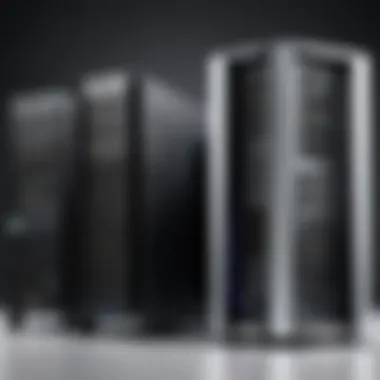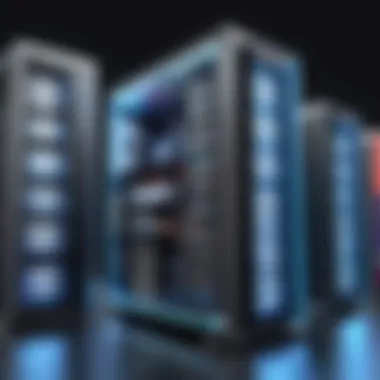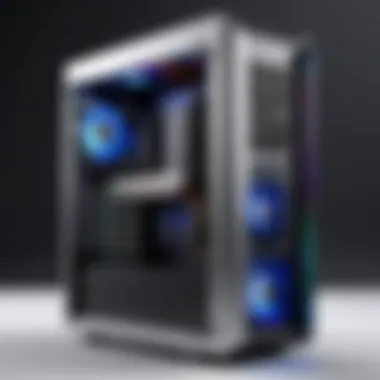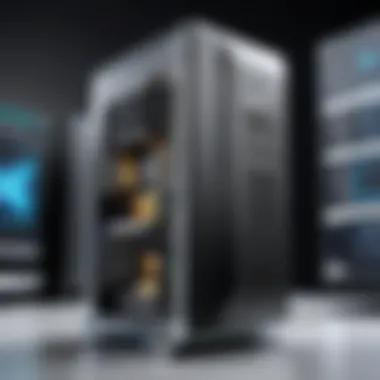Understanding Computer Tower Sizes: A Complete Guide


Intro
The landscape of computer towers is diverse, reflecting a variety of sizes and configurations. Each size brings its own advantages, challenges, and ideal use cases. Understanding these distinctions is crucial for making informed decisions, particularly for tech enthusiasts, gamers, and professionals.
Selecting the right computer tower can significantly impact performance, usability, and even the aesthetic appeal of your workspace. This guide delves into the details of different tower sizes, analyzing their key features, technical specifications, and practical applications.
Overview of the Product
Purpose and Benefits
Computer towers serve as the backbone of desktop systems, housing critical components such as the motherboard, CPU, RAM, and storage drives. The choice of tower size affects not only the internal layout but also airflow, cooling efficiency, and upgrade possibilities.
The benefits of knowing about tower sizes include:
- Optimized Performance: Choosing the right size can enhance cooling and airflow, leading to better performance.
- Space Efficiency: Different sizes cater to varying workspace dimensions, allowing for greater flexibility in setup.
- Aesthetic Appeal: An attractive design may complement office or gaming setups.
Target Audience
The information in this guide will particularly interest:
- Tech Enthusiasts: Those looking to build their own systems will benefit from understanding how tower size influences choice.
- Gamers: Competitive gamers require systems that can accommodate high-performance components.
- Professionals: Users with specific needs for workstations can optimize their setups.
Key Features
Different tower sizes offer unique characteristics:
- Full Towers: Ample space for powerful components and extensive cooling solutions.
- Mid Towers: A balance between size and functionality, suitable for most builds.
- Mini Towers: Compact designs ideal for limited spaces, though they may restrict component choices.
Technical Specifications
Detailed Product Specs
The specifications of a computer tower often include dimensions, material construction, and internal layout options.
- Full Tower: Typically measures 20+ inches in height, ideal for extensive builds.
- Mid Tower: Generally 16-20 inches, versatile for gaming and professional use.
- Mini Tower: Below 16 inches, targeting users with small spaces.
CPU Characteristics
The right tower size can accommodate a variety of CPU coolers. Full towers generally allow larger coolers, while mini towers might limit which heatsinks can be used.
GPU Features
Larger towers can generally support longer graphics cards, whereas compact designs may restrict GPU choice due to length and cooling requirements.
Memory Details
The configuration and capacity of installed RAM can also vary based on tower size. Full towers often provide better memory clearance, accommodating high-profile cooling solutions.
Performance Benchmarks
Selecting the appropriate size can indirectly affect performance. Systems in larger towers often enjoy better thermal performance due to superior airflow.
Comparison with Similar Products
Market Competitors
The market includes several established brands, such as Corsair, NZXT, and Fractal Design. Analyzing popular models helps understand the competitive landscape.
Comparative Analysis
When comparing similar-sized towers from different manufacturers, consider:
- Cooling Options: Number of fan mounts or radiator placements.
- Cable Management: Design features that enhance tidiness and airflow.
- Build Quality: Durability and aesthetic finish.
Best Use Cases
- Gaming: Full and mid towers are preferred for performance-oriented builds.
- Office Use: Mid and mini towers work well for everyday tasks.
- Development Workstations: Full towers support powerful configurations better.
Installation and Setup Guide
Requirements for Installation


Before proceeding with installation, verify:
- Component Compatibility: Ensure your components fit the chosen tower.
- Tools Needed: Basic tools such as a screwdriver, and sometimes a PSU tester.
Step-by-Step Process
- Unbox the tower and inspect for damages.
- Prepare components and tools.
- Install the power supply unit (PSU), ensuring correct placement for cables.
- Mount the motherboard carefully, securing it with screws.
- Install the CPU, cooler, and RAM, watching for compatibility.
- Add storage drives and any additional components, ensuring cable management.
Tips for Optimizing Setup
- Use modular power supplies when possible for cleaner setups.
- Prioritize airflow by positioning fans correctly.
- Regularly dust the interior for ongoing performance.
Answers to Common Questionss and Troubleshooting
Common Issues and Solutions
- Overheating: Ensure all fans are operational and not clogged with dust.
- Component Fitment: Double-check dimensions of larger GPUs versus tower specifications.
Expert Tips
- Always consult the manufacturer's manual for specific instructions.
- Utilize online forums such as Reddit for user-shared experiences.
Prelims to Computer Tower Sizes
Computer towers come in various shapes and sizes, each serving specific functions and fitting different needs. Understanding computer tower sizes is crucial for anyone looking to build or upgrade their system. This article covers the classifications of computer towers, their unique characteristics, and how they cater to different user needs.
Definition of Computer Towers
A computer tower refers to the enclosure that houses the primary components of a personal computer (PC). This includes the motherboard, power supply, and storage devices, along with other hardware such as graphics cards and cooling systems. The term 'tower' often implies a vertical desktop arrangement, differing from traditional desktops or laptops. Each type of tower has its dimensions and layout, making some styles suitable for specific uses more than others.
Importance of Tower Size
The size of the computer tower significantly impacts performance, usability, and even aesthetics. A larger tower can typically accommodate more components, which is essential for gamers or professionals who need advanced graphics cards or extensive storage solutions. Additionally, cooling opportunities often increase with size, as airflow in bigger towers is generally more efficient. It's vital to consider the available space and the hardware requirements.
It is also essential to understand the implications of aesthetics. A well-chosen tower can greatly enhance the overall look of a setup. For example, a sleek mid-tower could fit well in a modern workspace while a full tower may appeal to those who prioritize performance over design. Ultimately, selecting the correct tower size can create a harmonious balance between functionality and style, making it a key factor to consider in any computer build.
Types of Computer Tower Sizes
Understanding the various types of computer tower sizes is essential for both performance and usability. Different tower sizes accommodate specific components and can greatly influence the overall setup. By knowing the strengths and weaknesses of each size, users can make an informed decision that aligns with their needs. Thus, evaluating these types allows for better optimization of performance and design preferences.
Full Tower
Specifications
Full towers are the largest among the standard computer tower sizes. Typically, they stand at around 20 to 26 inches tall and measure about 8 to 10 inches in width. This size provides ample space for numerous components, including multiple GPU configurations and extensive cooling systems. One of the key characteristics of full towers is their support for large motherboards, including E-ATX and XL-ATX.
This makes them a beneficial choice for builders seeking maximum performance and flexibility. The larger size also permits easier cable management and better airflow, enhancing the overall building experience.
Use Cases
Full towers are particularly advantageous for enthusiasts and gamers who demand high performance. They are suitable for workstation setups where multiple graphics cards and large cooling systems are necessary. Moreover, their spacious design allows for extensive upgrades over time. A potential disadvantage is the footprint; they can be overbearing in small spaces. However, for those needing powerful rigs, full towers provide unmatched capabilities.
Mid Tower
Specifications
Mid towers typically range from 15 to 20 inches in height and about 7 to 8 inches in width. They can accommodate standard ATX motherboards quite comfortably. One key feature of mid towers is that they strike a balance between size and expandability.
This size offers enough room for decent cooling options while being more compact than full towers. The specification also allows for several drive bays and good airflow, keeping components cool, which is crucial in maintaining performance.
Use Cases
Mid towers are very popular among casual gamers and general users. They fulfill most gaming and everyday computing needs without occupying excessive desk or floor space. These towers support medium-level builds and upgrades efficiently, making them excellent for users with evolving requirements. However, for those looking for extreme setups, they may feel constricted in terms of expansion opportunities.
Mini Tower
Specifications
Mini towers are on the smaller side, generally measuring around 12 to 15 inches tall and about 6 to 8 inches wide. They are designed to hold micro-ATX motherboards, making them a compact solution for those short on space.
A key feature of mini towers is their limited expansion capability; they often have fewer slots for additional drive bays. This could be seen as a drawback for some users but does contribute to a more compact design.


Use Cases
Mini towers are ideal for basic computing tasks, office setups, or compact gaming rigs. They are great for users who prioritize desk space and do not need extensive hardware. The limitation in upgrades, however, means they are not fit for high-performance gaming systems requiring multiple GPUs or extensive cooling setups. Hence, a mini tower's appeal lies in its practicality for specific, simple tasks.
Micro Tower
Specifications
Micro towers are among the smallest options available, usually standing at around 10 to 12 inches in height. They cater to even less demanding specifications than mini towers, often supporting mini-ITX motherboards. One key characteristic is their extreme space-saving design, which can fit into very small areas.
However, this style inherently limits the number of internal components that can be installed, making them less versatile.
Use Cases
Micro towers are suitable for very basic tasks like browsing and office productivity. They are well-suited for environments where space is a premium, such as small offices or bedrooms. Their lightweight and compact nature makes them portable and easy to transport. The downside is that they usually lack the processing power for more demanding applications, making them less effective for gaming or heavy multitasking.
Compact Tower
Specifications
Compact towers serve as a bridge between larger models and smaller mini or micro towers. They typically measure between 14 to 16 inches in height. While they accommodate more components than micro towers, their internal architecture still remains tight. They allow for standard ATX motherboards while providing reasonable airflow and cooling capabilities.
Use Cases
Compact towers are advantageous for users who want a space-efficient solution without sacrificing too much computing power. They can contain moderately powerful builds while maintaining a small footprint. However, users may still face constraints if they plan to expand their systems significantly in the future. So compact towers strike a balance between space and capability but could be limiting for future upgrades.
Custom and Hybrid Sizes
Characteristics
Custom and hybrid sizes are tailored to meet specific user needs. Builders can modify the dimensions of the components to create systems that fit unique spaces or requirements. The flexibility of these builds allows for personalized options like vertical cases or open-air designs. One key characteristic is this customization often leads to improved thermal performance and aesthetics.
Situational Applications
This type is especially useful for users with uncommon needs, such as specialized workstations or gaming rigs. They can adapt to specific environments, whether cramped spaces or tailored to individual workflow requirements. Nevertheless, these customized solutions may require more planning and could involve additional costs related to the components used.
In summary, the choice of computer tower size plays a crucial role in system performance and accessibility. By thoroughly understanding each type and its characteristics, users can select a tower that aligns closely with their needs and preferences.
Factors Influencing Tower Size Selection
Choosing the right computer tower size involves careful consideration of several factors that directly impactful the functionality and usability of the setup. The size is not just aesthetic; it can influence performance, ease of build, and future upgrades. A clear understanding of these factors ensures that users make informed decisions tailored to their specific needs.
Space Considerations
When selecting a computer tower, space limitations are often the most crucial factor. A full tower may offer more room for components but might not fit in smaller work areas. Users should measure their available space to avoid purchasing a tower that can't be accommodated.
It is essential to also consider the location of the tower. For example, if it is housed next to other furniture or in a corner, airflow might be compromised. Thus, finding a balance between tower size and available physical space is critical. Additionally, the positioning might impact accessibility and other factors like cable management.
Component Compatibility
Not all components fit within every tower size. Depending on the size of the tower, users must ensure that the motherboard, graphics card, and power supply can all coexist without issues. Full towers generally support larger components and enable better airflow and thermal management.
Understanding the dimensions of various hardware and cross-checking them against the specifications of the chosen tower is necessary. A common mistake is assuming all parts fit fine without verification, which can lead to complications during assembly. Compatibility also impacts upgrading in the future, as many components can become outdated, requiring replacements.
Cooling Requirements
Effective cooling is vital for the performance and longevity of the components within any computer system. Larger towers, such as full and mid towers, provide more options for fans and radiators, which can significantly lower temperatures.
Gaming and professional systems often demand more cooling solutions, especially when operating under heavy loads. It is vital to assess if the chosen tower can accommodate sufficient thermal management systems. Smaller towers may limit options, leading to potential heat issues in high-performance builds, while bigger towers offer flexibility. Users must carefully evaluate their cooling needs in relation to the tower size.
Aesthetic Preferences
Aesthetic appeal is often subjective but plays an important role for many users. Some individuals prioritize a sleek, minimalist look, while others may opt for RGB lighting and glass panels. The size of the tower can directly affect this visual impression. Larger towers typically provide more surface area for decorative elements.
Each size has its own aesthetic values that may attract different users. Individuals need to consider how the tower will fit into their overall setup and what look they aim to achieve. This can also affect how people perceive the system, particularly in a professional or gaming environment. Making choices rooted in personal taste while considering functionality can lead to a better overall experience.
Performance Considerations by Tower Size
When selecting a computer tower, one must consider performance related to size. Different tower sizes bring unique advantages and limitations. Understanding these aspects can help in making more informed decisions for specific use cases, optimizing the overall computing experience.
Thermal Management


Thermal management is critical for any computer system. The size of the tower directly correlates with its capacity to manage heat. Full towers typically allow for more space for cooling solutions, including larger fans or liquid cooling systems. Consequently, they can disperse heat more effectively, which is essential for high-performance components.
Mid and mini towers, while still competent, may have limitations regarding airflow. They might restrict the number of cooling options due to their confined space. As a result, users must be proactive in monitoring temperatures and may need to invest in premium cooling solutions.
Key considerations for thermal management include:
- Cooling System Options: Larger towers can accommodate multiple or larger cooling systems.
- Airflow Design: Look for towers with optimized airflow paths for better cooling performance.
- Material Quality: Consider metal cases for better heat dissipation compared to plastic.
Expansion Capabilities
Expansion capabilities are another essential performance trait influenced by tower size. Full towers are designed with numerous expansion slots. This allows users to add various components such as additional graphics cards, storage drives, or cooling solutions. This versatility makes them ideal for gamers and professionals who anticipate future upgrades.
In contrast, mid and mini towers often limit expansion options. Although these towers can still offer a sufficient number of slots for essential upgrades, potential buyers should pay attention to their specific needs. Those looking to build a powerful multi-GPU system or extensive storage network may find these smaller towers insufficient in this regard.
Considerations for expansion capabilities include:
- Number of PCIe Slots: Check how many graphics cards or expansion cards can fit.
- Drive Bay Availability: Ensure there are enough bays for HDDs or SSDs.
- Motherboard Compatibility: Confirm that the tower supports the intended motherboard size.
Noise Levels
Noise levels can significantly impact user experience, especially for those who prioritize quiet operation. Generally, larger towers accommodate larger fans that can move more air at lower speeds, reducing noise. They offer better thermal management without requiring high-speed cooling solutions.
Conversely, smaller towers often need smaller, faster fans, which can generate more noise. This factor is especially relevant for users building a silent workstation or a gaming rig that operates at peak performance without additional sound. Choosing the right size can help mitigate noise issues effectively.
Tips for managing noise levels include:
- Fan Size: Select larger fans for quieter performance.
- Sound-Dampening Materials: Look for cases with built-in sound absorption features.
- Placement: Consider the location of the tower in your setup.
Performance considerations vary significantly across tower sizes. Understanding these differences is vital for optimal setup and user experience.
Trends in Computer Tower Sizes
Understanding the trends in computer tower sizes is essential for anyone interested in the evolving landscape of computer hardware. This section highlights how consumer preferences and technological advancements influence the design and functionality of these towers. Awareness of these trends can help users make informed decisions, leading to better performance, improved aesthetics, and increased usability.
Shift Towards Smaller Towers
In recent years, there has been a noticeable shift towards smaller computer towers. This trend aligns with the growing need for more efficient use of space, particularly in urban environments where real estate comes at a premium. Smaller towers can easily fit in compact workspaces without sacrificing necessary functionality.
Advantages of Smaller Towers:
- Space Efficiency: Smaller towers allow for better use of physical space, making them ideal for users with limited desk areas.
- Portability: Many users, especially students or professionals on the go, prefer a lighter and more portable setup.
- Simplicity in Design: Smaller cases often feature simpler designs that appeal to those who prefer a minimalist aesthetic.
However, smaller towers also come with limitations. They may restrict the number of components that can be installed, impacting expandability. Gamers and power users, for example, might find smaller options limiting for high-end graphics cards or cooling systems. As such, careful consideration is required when opting for a smaller tower.
Modular and Custom Solutions
Another emerging trend is the rise of modular and custom solutions in computer tower design. This trend caters to the individual’s desire for personalization and adaptability in their build. Modular components allow users to easily upgrade or replace parts without needing to buy an entirely new case.
Key Features of Modular Designs:
- Flexibility: Users can configure their setup according to specific needs, such as cooling options or aesthetic preferences.
- Easy Upgrades: As technology advances, modular designs make it easier to swap out components for better performance.
- Enhanced Cooling Solutions: Customizable airflow options can significantly improve thermal management, an essential aspect for performance-bound tasks.
The capability to create a build that reflects personal taste while accommodating the latest technologies is highly appealing. This trend signifies a move away from one-size-fits-all storage solutions, advancing towards tailor-made environments that reflect the diverse needs of users in gaming, professional settings, or casual use.
As technology continues to evolve, small and modular towers are likely to be at the forefront of the market, reflecting user demands for space-saving and customizable solutions.
Finale and Recommendations
In this article, we have delved into the various aspects of computer tower sizes. Understanding tower sizes is critical for several reasons. First, it influences the overall system performance and compatibility of components. A mismatched tower and component size can lead to thermal issues, reduced performance, or even premature hardware failure.
Choosing the Right Size for Your Needs
Selecting the right tower size begins with assessing your requirements. Consider the following elements:
- Space availability: Evaluate where the computer will be placed. Full towers need more room than mini towers.
- Usage scenario: For gaming, a larger tower often allows better cooling solutions and more expandability.
- Components: Verify compatibility of graphics cards, motherboards, and cooling systems to ensure that they fit well within the chosen tower size.
- Aesthetic preference: The visual aspect also matters. Some users prefer sleek and compact designs while others prefer larger, more customizable setups.
Based on these points, the right choice will greatly enhance efficiency and usability. A well-matched tower can boast better airflow, easier upgrades, and an overall pleasant working experience.
Future Considerations
As technology evolves, so does the design and functionality of computer towers. Here are several factors to keep in mind moving forward:
- Emerging form factors: Continuous innovation may bring new sizes or designs that fit better in various spaces while maximizing performance.
- Cooling technology advancements: Improved cooling options may allow smaller towers to support high-performance components, making them more desirable.
- Sustainability practices: Increasingly, consumers seek eco-friendly solutions. Expect a rise in towers designed with sustainable materials.
- User customization: As preferences grow for personal setups, we may witness more modular and interchangeable parts in tower designs.
Staying updated with trends and advancements in technology will aid in future decision-making regarding computer towers. The landscape will change, and being informed will ensure that your system meets your evolving needs effectively.
Remember: The right size is a balance of performance, space, and personal taste. Trying to fit large components in cramped spaces will only lead to frustration.



